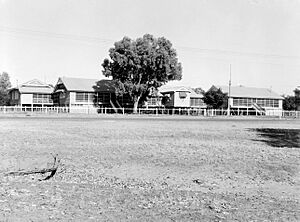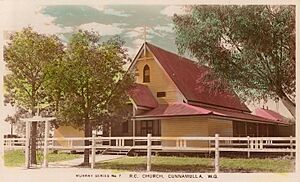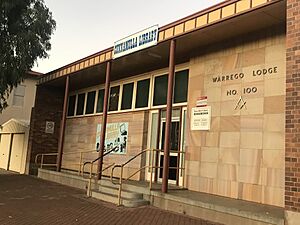Cunnamulla facts for kids
Quick facts for kids CunnamullaQueensland |
|||||||||||||||
|---|---|---|---|---|---|---|---|---|---|---|---|---|---|---|---|

Cunnamulla war memorial, 2010
|
|||||||||||||||
| Population | 1,233 (2021 census) | ||||||||||||||
| • Density | 0.26856/km2 (0.6956/sq mi) | ||||||||||||||
| Established | 1868 | ||||||||||||||
| Postcode(s) | 4490 | ||||||||||||||
| Elevation | 189 m (620 ft) | ||||||||||||||
| Area | 4,591.1 km2 (1,772.6 sq mi) | ||||||||||||||
| Time zone | AEST (UTC+10:00) | ||||||||||||||
| Location |
|
||||||||||||||
| LGA(s) | Shire of Paroo | ||||||||||||||
| County | Wellington County, Queensland | ||||||||||||||
| State electorate(s) | Warrego | ||||||||||||||
| Federal Division(s) | Maranoa | ||||||||||||||
|
|||||||||||||||
|
|||||||||||||||
Cunnamulla is a town in Queensland, Australia. It is about 206 kilometres (128 mi) south of Charleville. It is also about 750 kilometres (466 mi) west of Brisbane, the state capital.
In 2021, the town of Cunnamulla had a population of 1,233 people.
Contents
Exploring Cunnamulla's Location
Cunnamulla is located in South West Queensland. It sits right on the Warrego River, which is part of the large Murray–Darling river system. The river flows through the town from north to south.
Two main highways meet in Cunnamulla. The Mitchell Highway runs north to south, and the Balonne Highway comes in from the east. The Bulloo Developmental Road starts here and heads west.
Cunnamulla is the main town for the Shire of Paroo council area. This area also includes the towns of Wyandra, Yowah, and Eulo. The whole shire covers a huge area of about 47,617 square kilometres (18,385 sq mi).
The main jobs in the area are farming cattle, sheep, and goats. Tourism and opal mining are also important industries here.
A Look at Cunnamulla's Past
Indigenous Heritage and Early Days
The original people of this land are the Kunja. Their language, Gunya, is spoken in the area around Cunnamulla.
The first European explorer to visit was Edmund Kennedy in 1847. He saw fields of native grasses that looked like they were being farmed.
European settlers started arriving in 1861 to set up farms. The town of Cunnamulla got its name from a cattle station started in 1863. The name itself comes from an Aboriginal word for a deep waterhole in the Warrego River.
How Cunnamulla Grew
A settlement began here because there was a reliable waterhole. It was also where two major stock routes (paths for moving animals) crossed. In the late 1800s, Cunnamulla became a stop for Cobb and Co coaches, which were like old-time buses.
A survey of the town was done in 1868, and a courthouse was built that same year. The Cunnamulla Post Office opened on March 1, 1868.
Cunnamulla Provisional School started on July 9, 1877. It became Cunnamulla State School in 1885.
The Railway Arrives
In the late 1800s, there was a bit of a competition about where farmers would send their wool. New South Wales offered cheaper train prices than Queensland. To keep business in Queensland, the government decided to extend the Western railway line from Charleville to Cunnamulla.
There was a big discussion about where to put the train station in Cunnamulla. Some wanted it outside town to avoid floods, while others wanted it in the town centre. In the end, the Queensland Parliament chose the location north of the town. The railway line officially opened on October 10, 1898.
Churches and Schools
The Sacred Heart Catholic Church was opened in 1894. It was the first church in Cunnamulla. This building was replaced by a new church in 1972.
An Anglican church was also built, with its foundation stone laid in 1896. The church opened on June 20, 1896.
The Sacred Heart Primary School was opened in 1915 by the Sisters of Mercy.
A Royal Visit
In 1970, Queen Elizabeth II, Prince Philip, and Princess Anne visited Australia. Princess Anne spent three days on a working sheep station near Cunnamulla. She flew to Cunnamulla and then travelled by road to the station. She saw sheep shearing and wool classing, and even went for a horse ride.
Protecting the Town from Floods
Cunnamulla has experienced big floods in the past, like in 1990, 1997, 2010, and 2012. The 1990 flood was the highest on the Warrego River, reaching 10.15 metres (33.3 ft). To protect the town, an 11-metre (36 ft) high levee (a wall built to hold back water) was constructed.
Who Lives in Cunnamulla?
In 2021, Cunnamulla had a population of 1,233 people. About 44.4% of the people were Aboriginal and Torres Strait Islander. Most people (88.6%) were born in Australia, and 91.9% spoke only English at home.
When it comes to religion, the most common choices were No Religion (33.4%), Catholic (29.2%), and Anglican (18.8%).
Important Places in Cunnamulla
Cunnamulla has several places that are important for their history. These are called heritage-listed sites:
- Former Invincible Theatre, Jane Street
- Cunnamulla War Memorial Fountain, John Street
- Paroo Shire Honour Board, Civic Centre, Louise Street
- The Robbers Tree, Stockyard Street
- Cunnamulla Post Office, Stockyard Street
Learning in Cunnamulla
Cunnamulla has two schools:
- Cunnamulla P–12 State School is a government school for students from early childhood (Prep) up to Year 12. It is located at 17 Francis Street.
- Sacred Heart Primary School is a Catholic primary school for students from Prep to Year 6. It is located at 46 John Street.
Town Services and Fun Things to Do
Services and Facilities
Cunnamulla has important services like a magistrates court, a health care centre, and a fire station.
The Paroo Shire Council runs a public library at 16 John Street. St Albans Anglican Church is at 23 Emma Street.
Sports and Recreation
The town has a public swimming pool, a showground, and a racecourse.
Cunnamulla used to have a rugby league team called the Cunnamulla Rams. In 2022, they joined with another team to form the Western Ringers.
Tourist Attractions
If you visit Cunnamulla, you can explore two museums and a tourist information centre. There are also two caravan parks where visitors can stay.
Cunnamulla's Weather
Cunnamulla has a hot, dry climate. Summers are very hot, and winters are mild, sometimes with a little frost. The average highest temperature in January is about 36.2°C (97.2°F), and in July, it's about 18.9°C (66.0°F).
The town doesn't get much rain, averaging about 374.8 millimetres (14.76 in) per year. Most of the rain falls in summer. Cunnamulla is a very sunny place, with many clear days each year.
The hottest temperature ever recorded was 47.2°C (117.0°F) in January 2014. The coldest was -2.2°C (28.0°F) in June 1971 and July 1968.
| Climate data for Cunnamulla (28º04'12"S, 145º40'48"E, 189 m AMSL) (1879-2024 normals, extremes 1957-2024) | |||||||||||||
|---|---|---|---|---|---|---|---|---|---|---|---|---|---|
| Month | Jan | Feb | Mar | Apr | May | Jun | Jul | Aug | Sep | Oct | Nov | Dec | Year |
| Record high °C (°F) | 47.2 (117.0) |
45.6 (114.1) |
43.3 (109.9) |
37.3 (99.1) |
32.7 (90.9) |
30.4 (86.7) |
31.8 (89.2) |
36.8 (98.2) |
40.7 (105.3) |
42.0 (107.6) |
45.4 (113.7) |
46.2 (115.2) |
47.2 (117.0) |
| Mean daily maximum °C (°F) | 36.2 (97.2) |
35.0 (95.0) |
32.5 (90.5) |
28.1 (82.6) |
23.0 (73.4) |
19.4 (66.9) |
18.9 (66.0) |
21.5 (70.7) |
25.7 (78.3) |
29.8 (85.6) |
32.9 (91.2) |
35.3 (95.5) |
28.2 (82.7) |
| Mean daily minimum °C (°F) | 22.4 (72.3) |
21.8 (71.2) |
19.0 (66.2) |
14.3 (57.7) |
9.9 (49.8) |
6.9 (44.4) |
5.8 (42.4) |
7.2 (45.0) |
10.8 (51.4) |
14.9 (58.8) |
18.2 (64.8) |
20.9 (69.6) |
14.3 (57.8) |
| Record low °C (°F) | 13.0 (55.4) |
11.5 (52.7) |
4.4 (39.9) |
4.6 (40.3) |
−1.1 (30.0) |
−2.2 (28.0) |
−2.2 (28.0) |
−1.0 (30.2) |
2.0 (35.6) |
3.3 (37.9) |
7.8 (46.0) |
11.5 (52.7) |
−2.2 (28.0) |
| Average precipitation mm (inches) | 48.2 (1.90) |
49.9 (1.96) |
41.7 (1.64) |
26.5 (1.04) |
29.3 (1.15) |
25.9 (1.02) |
22.5 (0.89) |
17.2 (0.68) |
18.5 (0.73) |
25.5 (1.00) |
30.7 (1.21) |
38.6 (1.52) |
374.8 (14.76) |
| Average precipitation days (≥ 1.0 mm) | 3.6 | 3.3 | 3.1 | 2.0 | 2.5 | 2.9 | 2.5 | 2.0 | 2.2 | 3.0 | 3.4 | 3.3 | 33.8 |
| Average afternoon relative humidity (%) | 29 | 32 | 32 | 34 | 40 | 44 | 40 | 32 | 26 | 25 | 25 | 24 | 32 |
| Average dew point °C (°F) | 11.8 (53.2) |
12.7 (54.9) |
10.5 (50.9) |
8.3 (46.9) |
7.0 (44.6) |
5.7 (42.3) |
3.5 (38.3) |
2.5 (36.5) |
2.8 (37.0) |
4.5 (40.1) |
6.7 (44.1) |
8.2 (46.8) |
7.0 (44.6) |
| Source: Bureau of Meteorology (1879-2024 normals, extremes 1957-2024) | |||||||||||||






